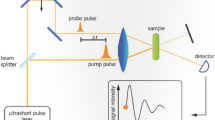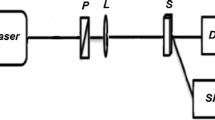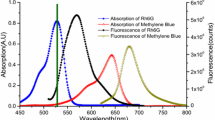Abstract
This study utilized the laser “pump–probe” technique to investigate the properties of a rhodamine 6G laser dye. A 532-nm wavelength laser was employed for excitation of the dye “pumping,” while another laser with a wavelength of 657 nm was utilized for the sensitization “probe.” A copper nanomaterial with an average size of 43 nm was added. The green laser pulse width was modulated at various percentages, including 5%, 10%, 20%, 30%, 40%, and 50% of the original pulse width. The pulse utilized for the pumping process was divided into two components: One of the two pulses was directed toward the dye, while the optical path of the other component (second pulse) was altered by employing multiple mirrors. The modification in the optical path was implemented to establish an accurate delay time between the two pulses and control their overlap by extending the duration of the laser pulse. The transmittance laser intensity was determined both before and after the addition of the nanomaterial. Additionally, the FWHM of the output laser pulse was computed. The wavelength of the output laser pulse was also determined through calculation. The study findings demonstrated a discernible impact resulting from the alteration of laser pulse width as well as the influence of the nanomaterial on the intensity and optical characteristics of the dye. This study is a component of a series of research endeavors focused on comprehending the interplay between nanomaterials and laser dyes as well as the resultant impact of these interactions on the characteristics of laser dyes.











Similar content being viewed by others
References
J. Picot-Clémente, Laser technologies for micro and nanofluidics systems: new opportunities for the biological and chemical industries. Photonics Views 20(1), 24–27 (2023)
G.M. Vanacore, A.W.P. Fitzpatrick, A.H. Zewail, Four-dimensional electron microscopy: ultrafast imaging, diffraction and spectroscopy in materials science and biology. Nano Today 11(2), 228–249 (2016)
G. Khitrova, P.R. Berman, M. Sargent, Theory of pump–probe spectroscopy. JOSA B 5(1), 160–170 (1988)
X. Zhua, T. Xua, Q. Lina, Y. Duan, Technical development of Raman spectroscopy: from instrumental to advanced combined technologies. Appl. Spectrosc. Rev. 49(1), 64–82 (2013). https://doi.org/10.1080/05704928.2013.798801
M. Fushitani, Applications of pump-probe spectroscopy. Ann. Rep. Sect. C Phys. Chem. 104, 272–297 (2008)
Y. Zhang et al., Probing ultrafast dynamics of ferroelectrics by time-resolved pump-probe spectroscopy. Adv. Sci. 8(22), 2102488 (2021)
W. Zhou, J. Yang, X. Wu, Y. Fang, L. Shen, Y. Song, A modified pump–probe method for sensitive measurement of optical nonlinearity. J. Opt. 22(6), 065503 (2020)
A.L. Whittock, T.T. Abiola, V.G. Stavros, A perspective on femtosecond pump-probe spectroscopy in the development of future sunscreens. J. Phys. Chem. A 126(15), 2299–2308 (2022)
J. Zhu et al., The ultrafast laser pump-probe technique for thermal characterization of materials with micro/nanostructures. Nanoscale Microscale Thermophys. Eng. 21(3), 177–198 (2017)
C. Dorow, An introduction to the technique and applications of pump-probe spectroscopy. Phys. (College Park Md) 2014, 1–7 (2014)
S.K. Rahi, M.J. Zoory, A.H. Ali, Development of probe technology by quantum overlap for controlling spectroscopic behaviors in organic dyes. J. Opt. 1, 21 (2023). https://doi.org/10.1007/s12596-023-01365-w
M. Wagner et al., Ultrafast and nanoscale plasmonic phenomena in exfoliated graphene revealed by infrared pump–probe nanoscopy. Nano Lett. 14(2), 894–900 (2014)
S.P. Patil, V.V. Burungale, Physical and chemical properties of nanomaterials, in Nanomedicines for Breast Cancer Theranostics (Elsevier, 2020), pp. 17–31
S. Yoshida et al., Probing ultrafast spin dynamics with optical pump–probe scanning tunnelling microscopy. Nat. Nanotechnol. 9(8), 588–593 (2014)
M. Segovia, X. Xu, High accuracy ultrafast spatiotemporal pump-probe measurement of electrical thermal transport in thin film gold. Nano Lett. 21(17), 7228–7235 (2021)
J. Jahng et al., Ultrafast pump-probe force microscopy with nanoscale resolution. Appl. Phys. Lett. 106, 8 (2015)
S. Terdale, A. Tantray, Spectroscopic study of the dimerization of rhodamine 6G in water and different organic solvents. J. Mol. Liq. 225, 662–671 (2017)
Y. Lu, A. Penzkofer, Absorption behaviour of methanolic rhodamine 6G solutions at high concentration. Chem. Phys. 107(2–3), 175–184 (1986)
Acknowledgements
The authors would like to extend their sincere gratitude to Mustansiriyah University (www.uomustansiriyah.edu.iq) in Baghdad, Iraq, for their invaluable support in facilitating the current study.
Author information
Authors and Affiliations
Corresponding author
Ethics declarations
Conflict of interest
The authors declare that there are no conflicts of interest concerning this research. The authors have not received any research funding from any organization or institution related to this study. This study was conducted through the personal efforts of the authors, and the results presented herein are the product of the researchers' dedication. Every effort has been made to uphold the integrity and objectivity of this research.
Data availability statement
The data that support the findings of this study are openly available in [research square.com] at (https://doi.org/https://doi.org/10.21203/rs.3.rs-3353042/v1).
Additional information
Publisher's Note
Springer Nature remains neutral with regard to jurisdictional claims in published maps and institutional affiliations.
Rights and permissions
Springer Nature or its licensor (e.g. a society or other partner) holds exclusive rights to this article under a publishing agreement with the author(s) or other rightsholder(s); author self-archiving of the accepted manuscript version of this article is solely governed by the terms of such publishing agreement and applicable law.
About this article
Cite this article
Rahi, S.K. Temporal overlapping effect of the pump–probe technique on rhodamine 6G with the addition of copper nanoparticles. J Opt (2023). https://doi.org/10.1007/s12596-023-01546-7
Received:
Accepted:
Published:
DOI: https://doi.org/10.1007/s12596-023-01546-7




